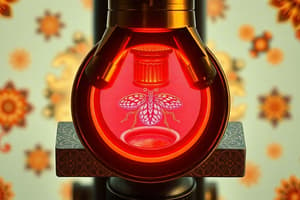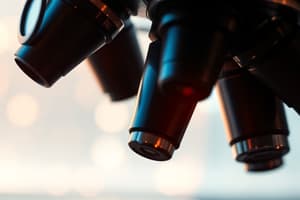Podcast
Questions and Answers
What are the common types of objective lenses?
What are the common types of objective lenses?
- High Power (40x, 100x) (correct)
- Macro Power (1x, 5x)
- Super High Power (200x, 400x)
- Low Power (4x, 10x) (correct)
What is the typical magnification of the eyepiece?
What is the typical magnification of the eyepiece?
10x
The _____ focus knob is used for initial focusing and moves the stage significantly.
The _____ focus knob is used for initial focusing and moves the stage significantly.
coarse
The mechanical stage allows for movement of the slide in multiple directions.
The mechanical stage allows for movement of the slide in multiple directions.
What type of illumination system provides adjustable brightness?
What type of illumination system provides adjustable brightness?
What is the function of diaphragm in an illumination system?
What is the function of diaphragm in an illumination system?
Flashcards are hidden until you start studying
Study Notes
Microscope Study Notes
Objective Lenses
- Primary lenses used to magnify the specimen.
- Common types:
- Low Power (4x, 10x): For initial observation and large specimens.
- High Power (40x, 100x): For detailed viewing.
- Typically multiple lenses are mounted on a revolving nosepiece for easy switching.
- Each lens has a specific numerical aperture, affecting resolution.
Eyepiece
- Also known as the ocular lens.
- Usually magnifies the image produced by the objective lenses (typically 10x).
- May include reticles for measurements or crosshairs for alignment.
- Designed for comfortable viewing, often adjustable for interpupillary distance.
Focus Knobs
- Mechanisms to adjust the distance between the objective lens and the specimen.
- Types include:
- Coarse Focus Knob: For initial focusing; moves the stage significantly.
- Fine Focus Knob: For precise adjustments; improves clarity at high magnifications.
- Essential for obtaining a clear image without damaging the slide or lens.
Stage
- Flat platform where specimens are placed for examination.
- Features:
- Stage Clips: Hold the slide in place.
- Mechanical Stage: Allows precise movement of the slide in multiple directions.
- Some stages have a built-in scale to measure specimen dimensions.
Illumination System
- Provides light to illuminate the specimen for clearer viewing.
- Types:
- Built-in Light Source: LED or halogen lamps, adjustable brightness.
- Mirror: Reflects ambient light for viewing in natural light conditions.
- May include a diaphragm to control light intensity and contrast.
Objective Lenses
- Primary lenses that magnify the specimen.
- Common types: Low Power (4x, 10x), High Power (40x, 100x).
- Used for initial observation (low power) and detailed viewing (high power).
- Mounted on a revolving nosepiece for easy switching.
- Each lens has a specific numerical aperture, which determines its resolution.
Eyepiece
- Also known as the ocular lens.
- Magnifies the image produced by the objective lenses (typically 10x).
- May include reticles for measurements or crosshairs for alignment.
- Designed for comfortable viewing, often adjustable for interpupillary distance.
Focus Knobs
- Mechanisms for adjusting the distance between the objective lens and the specimen.
- Types include: Coarse Focus Knob (initial focusing, significant stage movement) and Fine Focus Knob (precise adjustments, clarity improvement at higher magnifications).
- Essential for obtaining a clear image without damaging the slide or lens.
Stage
- Flat platform for placing specimens.
- Features: Stage Clips (hold the slide in place), Mechanical Stage (precise movement in multiple directions), built-in scale for measuring dimensions.
Illumination System
- Provides light for illuminating the specimen for clearer viewing.
- Types: Built-in Light Source (LED or halogen lamps, adjustable brightness), Mirror (reflects ambient light), Diaphragm (controls light intensity and contrast).
Studying That Suits You
Use AI to generate personalized quizzes and flashcards to suit your learning preferences.




